This article was first published in Issue 87 of Forty South print magazine, 2018.
Hobart is abuzz with activity these days. At the corner of Campbell and Collins Street on the fringe of the CBD a site in the old Wapping district is being excavated. An archaeologist chips away at brick footings and crumbling soil on the long-vacant block that is soon to be the University of Tasmania’s Academy of Creative Industries and Performing Arts.
It is now named ‘The Hedberg’ after the Hedberg Bros Garage the façade of which, along with the Theatre Royal, will remain in place to be incorporated into this stunning new development where construction has now begun.
It’s been a good day on the dig – the team has recovered a bone fishing spear head, a fragment of Chinese willow-pattern plate, a snuff bottle from Taddy, Tomlin, Hatfield & Friend, a Russian kopek, an East India coin and a cannon ball. But the prize find is a small, copper, one penny token found among the foundations of an old warehouse between the long-gone Shakespeare hotel and the Hedberg Garage. It is green with oxidisation and has the words O.H.HEDBERG SWEDISH HOUSE HOBART TON around its rim. The token, buried in that location quite by chance, was minted in 1854 by the grandfather of the Hedberg brothers, Dudley (Eric) and Trevor, who established the garage in 1926.

Olaf Hilmer Hedberg was a Swedish immigrant who arrived in Hobart in 1844 at the age of 27. He was an impressive man. He initially worked for wealthy Hobart ship owner, Charles Seal, and soon owned two whaling ships – the Victoria and Maid of Erin – that provided oil processed and exported by nine separate businesses in Hobart around that time. When the bottom fell out of the whaling market Olaf established an oil and colour store at 2 Argyle St, mentioned on the reverse of the coin. He offered the tokens, as many other tradespeople did, to overcome the chronic shortage of small change in the young colony.
Of course, the tokens were also a very effective means of advertising Olaf’s business. Newspaper advertisements for the store list an EXTENSIVE STOCK of CLARIFIED OILS, VIZ. — Black, at 2s 6d per gall, Black Fish at 3s 6d, Sperm at 7s . . . . as well as a quantity of Fashionable bed-room LAMPS, LAMPSHADES, of various sizes, Ditto GLASSES 7 & CHIMNIES, of every description. Neat’s Foot Oil, Sweet Oil and Turpentine, Floating lights and Fireworks completed the list.
Olaf was also Superintendent of Hobart Fire Brigade for 25 years. A commemorative award for 8 years of service, framed ornately in gold, shows a grey-bearded gentleman with bow tie and fireman’s cap. His obituary in 1884 describes him as filling the position with much proficiency and notes that he was very brave in extinguishing fires. A man of “Herculean strength”, he is reported to have carried trapped residents to safety and was praised for extinguishing a fire next to his shop in 1852. This fire started in Mr Gillies’ premises when Mr Joynes was preparing a tarpaulin steeped in a solution of naptha and oil for export to Port Philip.
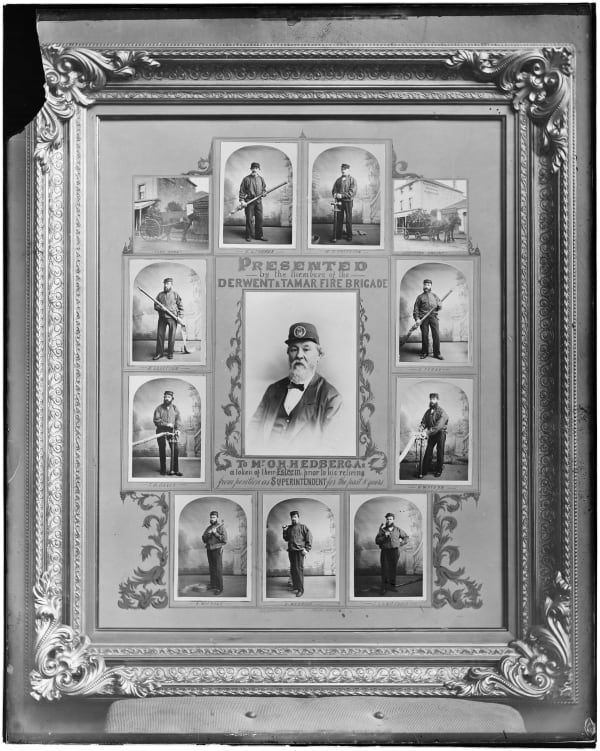
A report says it ignited and burned “with the most intense heat and fury, enveloping all around in the densest smoke”. Mr Hedberg’s solution was to demolish the adjoining weather board buildings with a grappling iron and chains, thus arresting the progress of the fire. Hobart’s Courier praised his “promptitude and energy”.
Later in the century Olaf raced yachts, such as the appropriately named Viking, in the Hobart Regatta. On his death in 1912, the Mercury’s yachting notes describe him as a “leading light in the Yachting world” and one who did a great deal towards improving the type of yachts on the Derwent. He built the Una, Vega, Gladys, Olga and Viking, as well as the Nordica that by “a peculiar coincidence” was wrecked on the day he died. Olaf’s obituary makes particular note of this “much-respected” resident of Hobart who went to sea at an early age and served for a time on the missionary schooner Triton in the Pacific. It concludes with the comment that his smiling face would be missed by many a friend. And, indeed, it is reported that all the boats in port had their flags half-masted on the days following his death.
It was a hard act to follow, but Olaf’s two sons Olaf Hilmer (Junior) and Oscar Elius did just that.
Oscar was born in Hobart in 1853, but joined the Victorian police force in 1874 where he was famously associated with the pursuit and arrest of the Kelly gang. He was also a popular man with a wide circle of friends who, between 1884 and his death in 1923, rose through the ranks of Inspector and Superintendent to be Governor of Hobart Gaol. On his death, one tribute notes that he took a great interest in swimming and that he, his father, and his brother between them saved 16 persons from drowning. Already as a “mere lad” he was presented with a gold watch for saving a boy from the Derwent!
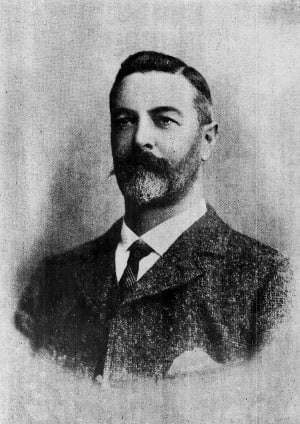
Olaf Junior was a brewer. He started work at Cascade Brewery as a youth and by 1879 had reached the position of head brewer. Then shortly before the death of John Degraves he became a collector of beer duty for Tasmania and was later head brewer for George Adams Tasmanian Brewery. As commissioner of beer tax, he recommended redefining beer to include only beverages above 2% alcohol, thus excluding dandelion ale and similar ‘light’ drinks. He retired in 1904 to grow hops at Bryn Estyn, New Norfolk, close to where his father was buried. Today a product called Hedberg Wheat Beer is brewed on the original site of Adams Brewery by Captain Bligh’s Ale and Cider using Midlands’ barley malt, hops from Bushy Park and some of the softest, cleanest water in the world.
Olaf’s son, the third Olaf Hilmer Hedberg (referred to as ‘Hilmer’), was another notable resident of Hobart. He became Salmon and Freshwater Fisheries Commissioner and an eminent member of the Animals and Birds Protection Board. A memorial to his work in the development of trout fishing in the State is still visible at the entrance to Salmon Ponds in Plenty.
His most important and lasting achievements, however, were as a member and chairman of the Protection Board. He deplored the killing of penguins on Bruny Island and ensured that the Board’s inspectors and police investigated. He denounced the use of rabbit traps for taking possums, calling the practice “the cruellest method possible”. On his retirement in 1953, Hilmer said he felt it was the duty of all Tasmanians to be interested in saving and preserving the natural life of the State and there was a danger that, unless care was taken, much of the flora and fauna would become extinct. How right he was . . . .

And no species was too humble to earn his respect. After his death a year later, it was recalled that he had willingly surrendered his patch of strawberries to the blackbirds, in order to have their beautiful music near his bedroom window when he wakened in the morning.
His brothers, Eric and Trevor, ran garages in Brisbane Street, Hobart, before building their new state-of-the-art garage in Lower Collins Street in 1926, that is included in the design of the University’s performing arts development due to be completed in 2019. The Hedberg Brothers building was spacious, with a large garage on the ground floor, a showroom in front and workshop at the rear.
The words MOON CARS appeared in prominent letters on the front of the building. These cars, manufactured by Joseph W. Moon in St Louis, USA, were at the peak of their popularity in the 1920s. For the opening of the new garage the brothers had on exhibition special model six Moon cars fitted with balloon tyres and hydraulic 4 wheel brakes. In a 1928 edition of The Mercury, the garage also advertised double-seater Crouch cars – England’s Wonder Car – model T Ford Tourers and a 5-seater Durant. In 1937 they offered second-hand Chevrolet Roasters “with excellent duco”, Chrysler and De Soto sedans, a Nash sedan in excellent condition and “Your Car traded in and easy terms for the balance”.
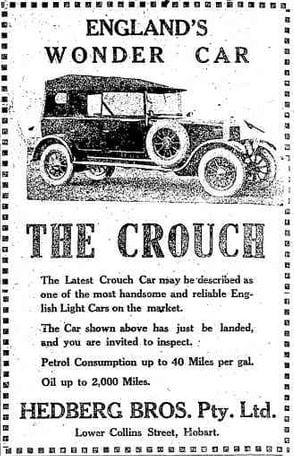
The brother’s role in 1920s Hobart included assisting police in the implementation of the new highway traffic patrol. They instructed patrolmen in motor mechanics and the use of brakes; the public safety of steering mechanisms and chassis parts; a knowledge of silencers, for prevention of the use of ‘cut outs’; and how to drive different makes of cars in cases of emergencies.
They gave evidence concerning the likely performance of cars in accidents. For example, their possible speed in relation to damage, the visibility at the time and consideration of such things as tyre marks. Newspaper reports show that they were involved in salvaging an overturned car on Horseshoe Bend between Pontville and Bridgewater, one of many crash sites they attended. Eric had served in the AIF Infantry Battalion and 2nd Division Motor Transport Company in Egypt, France and England from 1915-1919 and the garage was obviously very well regarded, for the owners were regularly requested to testify on such matters.
The Hedberg family’s link with ships and water races continued with Olaf Snr’s great, great, great grandson, Will Hedberg, crewing on the Brindabella in the 2013 Sydney Hobart Yacht Race. His father, the fourth Olaf (Ollie) Hilmer Hedberg, who turned 80 this year, was Commodore of the Royal Yacht Club of Tasmania in the 1980s, chairman of the race committee for the memorable Tall Ships Parade at Australia’s Bicentenary celebrations and is a Life Member of the Club. He was chairman of Public Sector Mapping Agencies (PSMA) Australia for eleven years and has worked extensively for Natural Resource Management in Tasmania. In 2008 he was awarded an AM in the Australia Day Honours for services to Land Information Tasmania and the national spatial information industry.
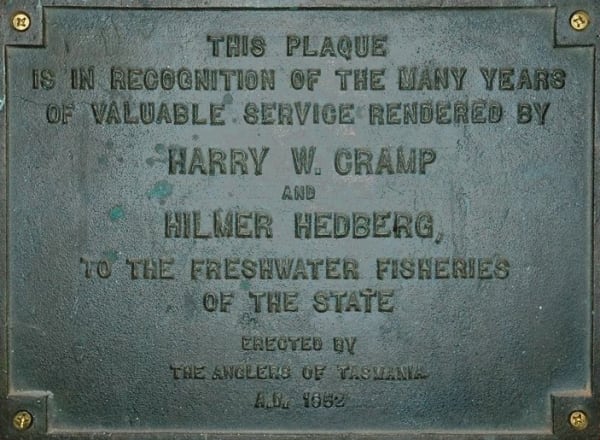
Naming the University’s new project ‘The Hedberg’ was an inspired choice. The achievements of the Hedberg family, including the status and quality of the motor business that stood on the site at the beginning of the previous century, is so obviously worthy of a project that will provide an educational facility incorporating high-end architectural design, sustainable services and cutting-edge acoustic features. But it is also fitting because the 21st century project embraces and celebrates the heritage of this corner of Hobart’s CBD by retaining the façade of the garage. The new building will also display artefacts discovered in the excavation – in situ – under a specially designed glass floor behind the garage façade. All this nestled on the brick footings and crumbling earth that has lain there for at least a century.
And the Wapping site was not the only place that Hedberg coins were found embedded in the soil.
A brief note in the Personal column of a 1929 edition of the Circular Head Chronicle records that “Dr Jackson recently found in his garden a copper one penny token issued by O.H. Hedberg, Oil and Colour Stores, Argyll St, Hobart Ton”. Dr William Jackson was a GP and apple orchardist in the Huon Valley in the 1920s who, on the side, imported daffodil bulbs from the UK. Growing daffodils later became a family business spanning five generations. Today, Jackson’s Daffodils at Surges Bay grow daffodils that win international prizes.
So the interests, expertise and contributions of Tasmania’s families weave through the generations to enrich our lives right up to the present time.
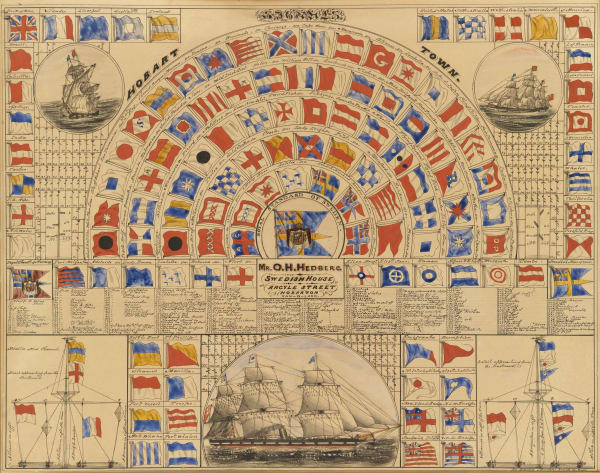
. . .
In August 2020, Forty South launched its digital platform, fortysouth.com.au, on the glittering main stage of the Theatre Royal and the shared foyers of The Hedberg. The web portal, and the rebranding of Forty South, were launched by the Governor of Tasmania, Her Excellency Professor The Honourable Kate Warner, in an event which can only be described as glittering, too. This Read about the our launch night here.
. . .
Carol Freeman is researcher and writer who has lived in Hobart for over 30 years. Her work appears in books and academic journals, exhibition catalogues and art magazines on topics that connect art, science and history in innovative and provocative ways. These include a co-edited book Considering Animals: Contemporary Studies in Human-Animal Relations, essays such as Is this Picture Worth a Thousand Words? in Australian Zoologist, catalogue essay Reconstructing the Animal for an exhibition at Tasmanian College of the Arts and book reviews for Historical Records of Australian Science. Her major publication, the book Paper Tiger: How Pictures Shaped the Thylacine, is published by Forty South. Since 2015 she has been a regular contributor to Forty South on a variety of subjects.










